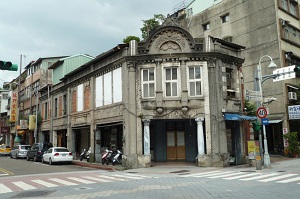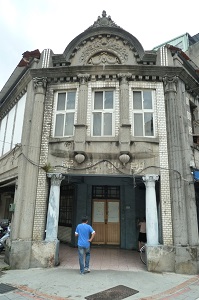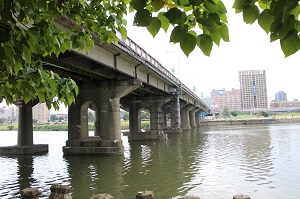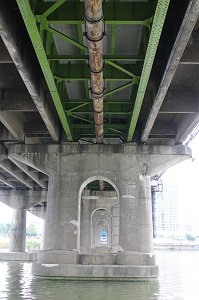Four historic places listed as municipal heritage sites
By Yali Chen Formerly known as Monga, Wanhua is Taipei’s oldest and most intriguing neighborhood. This area boasts historical sites, temples, traditional shopping streets, night markets, and local snacks. Located at the intersection of Sec. 2, Guiyang St. and Xiyuan St., the Zhaobei Hospital was considered one of the most famous hospitals in the Wanhua District during the period of Japanese rule from 1895 to 1945. Lee Zhaobei was regarded as the first medical practitioner in Monga during the Japanese colonial rule of Taiwan. He opened his hospital in 1921. The hospital was a two-floor Baroque-style building with red brick walls, a decorative stucco façade, and magnificent stone sculptures – encarpi (sculptured festoons of fruit, flowers, leaves, and drapery in classical architecture) in particular. It’s very rare to find this kind of sculptured ornaments in the capital city. In 2002, the Department of Cultural Affairs listed it as a temporary protected building because of its historical significance. Three years later, this well-preserved hospital was designated as a municipal heritage site by the DCA because it could offer a few glimpses of its original glory. The famous Herb Alley has also witnessed quite a few changes throughout the Wanhua Area over the past few decades. Popularly known as Herb Alley, or Ching Tsao Hsiang in Chinese, this is a short stretch off Xichang Street in the Wanhua District. Next to the noted Longshan Temple, that small alley with a length of less than 50 meters boasts a group of Chinese herbal shops. Each store is full with sacks of dried herbs, filled with baskets of fresh green herbs, or hung with aloe and cactus. At the beginning, rickshaws were used to carry herbs and gathered around the Longshan Temple. Later, some vendors opened their herbal stores on this street, thereby attracting more sellers to enter the Chinese herbal business. For the past few centuries, those who believe in the healing power of yaoqian always came to this herb market. But it was not until 1981 that the health authorities banned domestic temples from providing yaoqian for their believers. Thus, the lively market has gradually faded. In 2001, the Department of Cultural Affairs spent NT$2.6 million on renovating the famous Herb Alley. The entrance to the 50m-long, 6m-wide alley was designed to stand next to the south side of the Lungshan Temple. Acrylic signs in Chinese, English, and Japanese described the history of the alley and the development of Chinese herbs. Most herbal shops have been handed down from generation to generation. Some of them were registered as protected historical buildings this year by the DCA because they played a significant role in the history of Chinese herbal medicine. To offer a global aesthetic appeal for the city of Taipei, four major bridges of different structural configurations were constructed for crossing the Xindian Creek, Danshui River, and Keelung River. In some cases, steel plate girder bridges and suspension bridges were used for the Kawabata Bridge, later renamed the Zhongzheng Bridge after 1945, and the Syouwa Bridge, later renamed the Guangfu Bridge, across the upstream and downstream, respectively, of the Xindian Creek. A steel trussed bridge was used for the Taipei Bridge across the Danshui River, and a reinforced concrete arch bridge was used for the Meiji Bridge, later renamed the Zhongshan Bridge. The above four bridges are the main gates for residents from other parts of Taiwan to enter the city of Taipei. Their special geometrical shapes provide visitors with a vivid view of the growing strength of the capital city. Built in 1937, the Zhongzheng Bridge together with the Taipei Bridge, Guangfu Bridge and Zhongshan Bridge were regarded as the four famous bridges in the city of Taipei during the Japanese colonial rule, according to the Department of Cultural Affairs. Connecting the Yonghe Area in New Taipei City to the Da-an and Zhongzheng Districts in Taipei City, the Zhongzheng Bridge is filled with numerous speeding cars, trucks and motorcycles as well as a few bicycles and pedestrians on weekdays. But the 78-year-old bridge may not resist earthquakes and floods – two major natural threats to the bridges around Taiwan. Seismic force and flood-induced scouring effect typically cause tremendous damage to the bridges, resulting in their shorter service life. Thus, the Public Works Department of Taipei City Government plans to tear down the Zhongzheng Bridge and rebuild it in the near future because its high-level performance of seismic design technology is urgent. Disputes between the Public Works Department and Department of Cultural Affairs have been unable to settle. Protecting cultural heritage and implementing regional development policies should be balanced, the DCA Commissioner Ni Chung-hwa said, adding that the department will hear opinions from all sides through the creative workshop “idea Taipei.” During the Japanese colonial era, Yanping North Road in the Datong Area was called Taipingding – home to the Da Qian Department Store, the first in Taiwan to install an escalator; the Da’an Hospital and Taiwan Min Bao (Taiwan People’s Newspaper), founded by Taiwan’s democratic trailblazer Chiang Wei-shui; and the Dong Hui Fang Restaurant, which played host to Liang Qi-chao, the foremost intellectual leader of China in the first two decades of the 20th century. Next to the historical buildings including All Beauty Restaurant and the Da Qian Department Store, the clothing shop located on No.13, Sec. 2, Yanping N. Rd. was listed as the heritage site this year by the Department of Cultural Affairs. It was built in 1939 and renamed ABC Amis Clothing Store in the 1960s as Taiwan began to promote its exports and the international market was also booming. The Lee family ran this store and sold their garments to overseas. For the last few decades, the clothing shop has witnessed the rise and fall of Taipingding business development.
STAFF WRITER The Zhaobei Hospital in the Wanhua District was designated as a municipal heritage site on March 17 by Taipei Cultural Asset Review Committee under the supervision of the Department of Cultural Affairs (DCA). Meanwhile, the committee also listed the Zhongzheng Bridge, a clothing shop located on No.13, Sec. 2, Yanping N. Rd., and some historical houses on Herb Alley in the Wanhua Area as protected historic buildings because of their historical significance.
The Zhaobei Hospital in the Wanhua District was designated as a municipal heritage site on March 17 by Taipei Cultural Asset Review Committee under the supervision of the Department of Cultural Affairs (DCA). Meanwhile, the committee also listed the Zhongzheng Bridge, a clothing shop located on No.13, Sec. 2, Yanping N. Rd., and some historical houses on Herb Alley in the Wanhua Area as protected historic buildings because of their historical significance. In early times, west medicine was not popular in rural Taiwan or a practitioner of traditional Chinese medicine was hardly to come by. As people got sick or felt ill, they tended to rely on word-of-mouth herbal recipes or went to the Longshan Temple to ask for yaoqian (divine prescriptions including herbs, dosage, and symptoms on a slip of paper). After getting the recipe or yaoqian, they went to an herbal shop on Herb Alley and bought some herbs to stew.
In early times, west medicine was not popular in rural Taiwan or a practitioner of traditional Chinese medicine was hardly to come by. As people got sick or felt ill, they tended to rely on word-of-mouth herbal recipes or went to the Longshan Temple to ask for yaoqian (divine prescriptions including herbs, dosage, and symptoms on a slip of paper). After getting the recipe or yaoqian, they went to an herbal shop on Herb Alley and bought some herbs to stew. While the other three bridges are long gone, the Zhongzheng Bridge spanning the Danshui River is still standing nowadays and is seen as the oldest bridge in the capital city. In 2015, the DCA registered the oldest bridge as a historical site thanks to its cultural value.
While the other three bridges are long gone, the Zhongzheng Bridge spanning the Danshui River is still standing nowadays and is seen as the oldest bridge in the capital city. In 2015, the DCA registered the oldest bridge as a historical site thanks to its cultural value. Taipei’s Datong District is another area rich in culture, history and traditions. It also boasts numerous century-old buildings that have now been restored and transformed into cultural-creative centers. Some renovations not only give these old houses a new look, but also add brightness and luster to the local streetscape.
Taipei’s Datong District is another area rich in culture, history and traditions. It also boasts numerous century-old buildings that have now been restored and transformed into cultural-creative centers. Some renovations not only give these old houses a new look, but also add brightness and luster to the local streetscape.

![Taiwan.gov.tw [ open a new window]](/images/egov.png)
